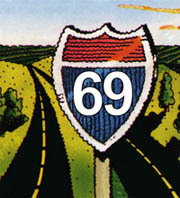• Congressional Action Sought for I-69 Signage
Every member of the U.S. House and U. S. Senate from Texas has signed on to co-sponsor a bill that will authorize Texas to post Interstate 69 signs on portions of US 77, US 59 and US 281 that meet interstate standards but do not yet connect to an existing interstate.
 Under federal law sections of these highways that meet interstate standard and connect to interstates are eligible for addition to the Interstate Highway System and I-69 signage. This includes approximately 75 miles of US 59 in the Houston region stretching from Spendora on the north to Rosenberg on the south. It also includes about 8 miles of US 77 that connects to I-37 near Corpus Christi. The Texas Department of Transportation (TxDOT) is seeking administrative approval from the Federal Highway Administration to sign these sections.
Under federal law sections of these highways that meet interstate standard and connect to interstates are eligible for addition to the Interstate Highway System and I-69 signage. This includes approximately 75 miles of US 59 in the Houston region stretching from Spendora on the north to Rosenberg on the south. It also includes about 8 miles of US 77 that connects to I-37 near Corpus Christi. The Texas Department of Transportation (TxDOT) is seeking administrative approval from the Federal Highway Administration to sign these sections.
The I-69 bill was introduced by Rep. Blake Farenthold, a freshman member from Corpus Christi whose District 27 includes more than 150 miles of the I-69 route in South Texas.
Congress designated sections US 59, US 281 and US 77 as part of the I-69 High Priority Corridor in the 1990s. When approved the bill would amend that law to add 30 miles of US 83 from Harlingen to McAllen to the designated I-69 corridor. This section of US 83 is a freeway that is already at interstate standard.
Significantly, the bill would allow about 80 miles of existing freeway in the Lower Rio Grande Valley to be added to the interstate system. The four Valley counties had a 2010 population of more than 1.2 million. When taken together with the adjoining cities across the Rio Grande, the metropolitan area has a population of more than 2.3 million -- about the same as Dallas County. The Valley is the largest urbanized area in the nation that is more than 100 miles from the nearest interstate highway.
Economic development professionals all up and down the I-69 route report that lack of a signed interstate highway is a roadblock to attracting new industries and better jobs to their communities.
An enormous investment has already been made in upgrading sections of the I-69 route and adding these sections to the Interstate System will increase the benefit of those investments. The Alliance believes that signing completed segments of the I-69 route with the interstate shield will create new economic opportunities and will lend additional urgency to the highway upgrade process.
Placement of Future Interstate Corridor informational signs was authorized more than a decade ago. The Alliance has taken every opportunity to argue that completed sections should be added to the Interstate Highway System and signed with the interstate shield.
Alliance Board Chair John Thompson told the Texas Transportation Commission in November, 2010, that "the Alliance is committed to working with local, state and federal officials to clearing the path for posting Interstate Highway signs on portions of US 59, US 77 and US 281 at the earliest practical time."
"Each of the communities along the corridor and the state as a whole will only realize the full benefit of Interstate 69 when the entire corridor is completed as a seamless interstate from Texarkana to the Lower Rio Grande Valley and Laredo," he said.

